Texas Palm Trees (With Pictures) – Identification Guide
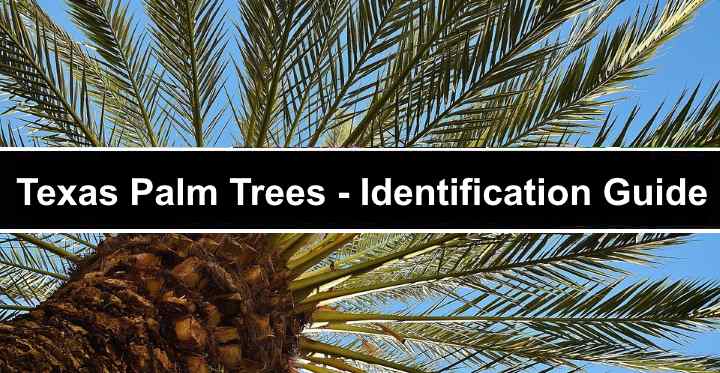
Growing palm trees in Texas isn’t only for the subtropical climates around the Mexican Gulf, Corpus Christi, Galveston, or San Antonio. Several species of cold-hardy palms thrive in North Texas, Dallas, Fort Worth, and even the Texas Panhandle. Texas palm trees range from the native sabal palm and dwarf palmetto to the tall, elegant palms like the Mexican fan palm and the queen palm tree.
Texas has a unique climate, making it challenging to find suitable palm trees for growing in a landscape. Although most palm trees perform best in subtropical and tropical climates, several species of temperate palms grow well in garden landscapes throughout the Lone Star state.
This article is a guide to identifying the best palm trees to grow in Texas. Descriptions and pictures of Texas palm trees will help you choose suitable landscaping palms for your garden landscape.
Growing Zones in Texas
Texas is divided into USDA growing zones 6 to 9. Within these zones are temperate climates in the north in cities like Amarillo, Plainview, and Lubbock. However, central and southeast Texas has a subtropical climate, and west Texas is an arid desert.
The extreme north of Texas in the Panhandle is zone 6. However, northwestern Texas, where Amarillo, Lubbock, and Plainview are located, is in USDA zone 7. Here, average winter temperatures can drop to between 5°F and 0°F (-15°C – -17.8°C). Additionally, snow is not uncommon in North Texas.
Northeastern and central Texas are generally in USDA zones 7 and 8. This zone includes cities like Dallas, Fort Worth, San Angelo, Austin, and San Antonio. Here winter temperatures may sometimes drop to between 20°F and 10°F ( -7°C to -12°C).
The warmest growing zone of Texas is zone 9, which includes the regions around the Mexican Gulf and areas south of San Antonio. Depending on proximity to coastal regions, drought-tolerant palms that withstand salt air perform best in sandy, well-drained soil.
It’s good to remember that Texas has a unique climate, and other conditions can affect how well individual palm trees grow. For example, soil type, proximity to lakes and rivers, elevation, and humidity can influence the type of palm tree to plant.
Palms for Growing in Texas
Tall palm trees are common in southern Texas, where the tall, slender trees with their crowns of arching fronds line streets and coastal areas. Palms tend to thrive in full sun in moderately fertile soil that drains well. Typically, palms either prefer heat and humidity or cold and dry conditions.
Cold hardy palms can withstand frost and snow in northern Texas, where temperatures dip below freezing. Cold hardy palms suitable for growing in North Texas include the needle palm (zone 6) and the windmill palm (zone 7).
Several palms suitable for zone 8 are ideal for growing in northeast Texas and central Texas. Some of the Texas palms include the native sabal palm and dwarf palmetto. However, other tall palm trees for the areas between Dallas Fort Worth and San Antonio include the California palm tree, Chilean wine palm, and the cabbage palm.
Most palm tree species are suitable for growing along the Gulf Coast, from east Texas, where Galveston and Houston are located to the west along the border with Mexico. Heat-loving palms for zone 9 include date palm trees, pindo palm, and the Mexican fan palm.
Types of Texas Palm Trees (With Pictures)
Let’s look in detail at the identifying features of Texas palm trees. Here you will find helpful information on where to grow species of palms in the Lone Star state.
Texas Sabal Palm Tree (Sabal mexicana)
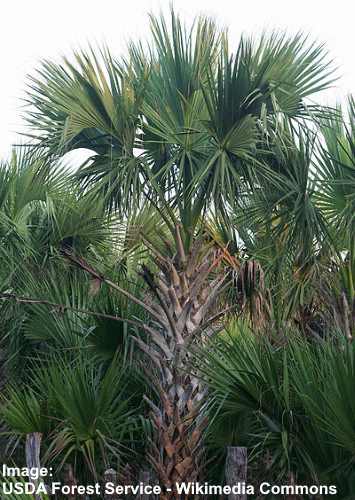
The native Texas sabal palm tree is suitable for growing in southern Texas
The Texas sabal palm is a robust native palm tree with a single trunk topped by large fan-shaped evergreen leaves. The attractive emerald-green palm fronds measure up to 6.5 ft. (2 m) wide, growing on 15 ft. (4.5 m) long stems, forming a thick, rounded crown.
The Texas sabal palm grows up to 50 ft. (15 m) tall and 25 ft. (7.6 m) wide. The native Texas tree is suitable for growing in southern Texas in zones 8 to 11. The Texas sabal palm thrives in high humidity, loamy, well-drained soils, and full sun. Plant as a specimen native tree to give visual appeal to garden landscapes.
Texas Palm Tree Identification
Also called the Texas palmetto, the sabal palm tree is identified by its vast palmate glaucous green leaves, clusters of creamy white flowers, and showy, black drupes.
Dwarf Palmetto Palm Tree (Sabal minor)
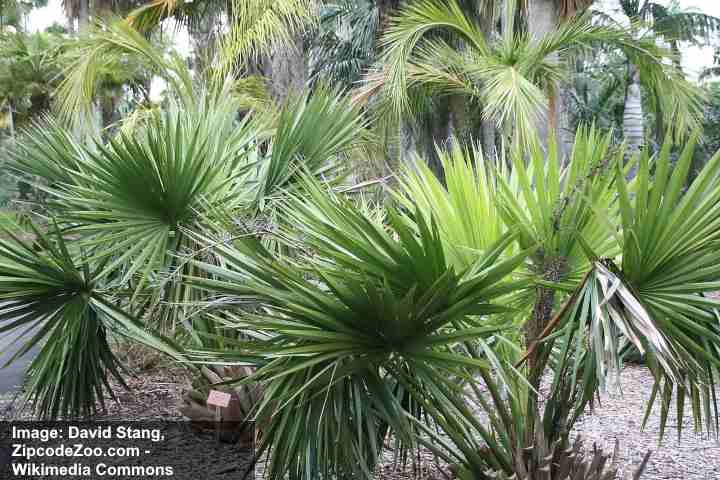
The cold hardy dwarf palmetto can be found in many habitats including central and south Texas
The dwarf palmetto palm is native to central Texas and northeastern Mexico. The flowering evergreen palm tree is identified by its fan-shaped leaves that sometimes grow straight from the ground. Its leaves with large, pointed segments measure 3 ft. (1 m) across and grow on smooth, spineless petioles.
Dwarf palmetto palm trees are drought and salt tolerant, suitable for growing throughout central and southern Texas. The low-growing, shrub-like tree grows 4 to 5 ft. (1.2 – 1.5 m) tall and wide. Its ornamental value makes it useful for growing in warm climates as a foundation plant or textural accent.
Texas Palm Tree Identification
The identifying features of the dwarf palmetto palm are its fragrant, creamy-white flowers, huge palmate leaves, and clusters of dark brown or black fruits.
Windmill Palm Tree (Trachycarpus fortunei)

The windmill palm tree is very hardy and slow growing small palm tree which is suitable to growing even in north Texas
The windmill palm is one of the cold-hardiest palm trees for growing in Texas. The small evergreen landscaping palm has dark-green, fan-shaped leaves growing on upward-pointing stiff petioles. Its bark is thick and cylindrical, covered with fibrous, shaggy hairs. The hardy palm tree grows 8 to 10 ft. (2.4 – 3 m) tall and up to 6 ft. (1.8 m) wide.
Also called the Chinese windmill palm tree, the attractive evergreen thrives in USDA zones 7 to 11. It can tolerate freezing temperatures and short cold snaps down to 5°F (-15°C). This makes the windmill palm tree suitable for growing in containers or as an accent plant as far north as Wichita Falls, Dallas, and Lubbock.
Texas Palm Tree Identification
The identifying characteristics of the windmill palm tree are its rough, stout trunk, spectacular clusters of dangling yellow summer flowers, and dark blue fruits.
Mediterranean Fan Palm Tree (Chamaerops humilis)

The Mediterranean dwarf palm tree has few trunks and is small enough to suit many gardens in central and south Texas
Also called the European palm, this cold-hardy palm tree grows as a medium-sized shrub or small tree. It’s a multi-trunked palm tree with rough, stout, suckering trunks, bluish-green fan-shaped leaves, and sharp, spiny petioles. The evergreen leaves measure up to 3 ft. (1 m) across, growing in a fan shape divided into spiky segments.
The Mediterranean fan palm tree is hardy in USDA zones 9 to 11. However, it’s very adaptable and tolerates extreme heat and cold, surviving temperatures as low as 10°F (-12°C). The sun-loving ornamental palm tree is suitable for growing in smaller spaces as lawn tree, or specimen palm in central and southern Texas and along the Gulf coast.
Texas Palm Tree Identification
The Mediterranean palm tree is identified by its multiple trunks and rounded crown, growing 6 to 15 ft. (1.8 – 4.5 m) tall. Other characteristics of the palm include clusters of bright-yellow flowers, brown or yellowish-orange fruits, and sharp petioles.
Date Palm Tree (Phoenix dactylifera)
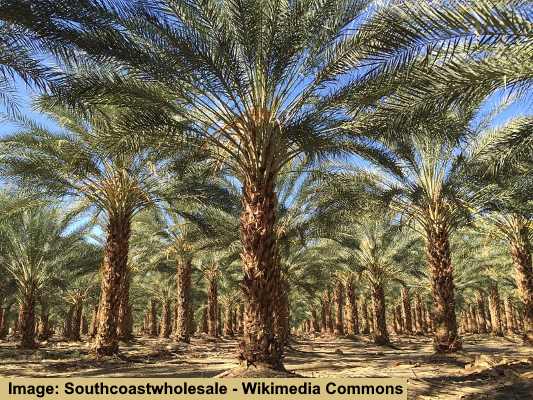
The date palm tree is common in southern and western Texas where it produces edible fruit
The date palm is one of the most well-known palms growing in Texas. This heat-loving tall palm tree has a rough, slender trunk with a spectacular crown of massive, upward growing, arching feather-like fronds. The palm leaves measure 10 to 16 ft. (3 – 5 m) long, containing up to 150 stiff, slender leaflets.
The date palm tree is slow growing and matures between 50 and 80 ft. (15 – 25 ft.) tall. Suitable for zones 9 to 11, the palm tree is also hardy in short freezing spells of 25°F (-4°C). In the hot, dry conditions of southern and western Texas, the palm trees produce sweet edible dates.
Texas Palm Tree Identification
The identifying traits of the Texas palm tree are its enormous arching pinnate fronds creating a spectacular crown of leaves. In addition, it produces showy clusters of yellow dates that turn brown and black as they ripen.
Dwarf Date Palm Tree (Phoenix roebelenii)
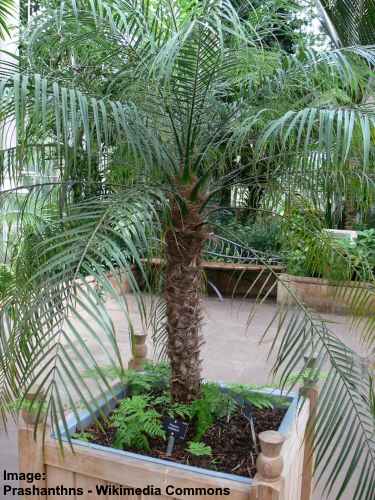
The dwarf date palm is a small tree suitable for growing indoors in the colder areas of Texas
The dwarf date palm is an excellent choice of palm tree in compact Texas garden landscapes. The small evergreen ornamental tree has all the attractive characteristics of the larger date palm, with lustrous green arching pinnate leaves that top the slender trunk. The dwarf palm tree grows 6 to 10 ft. (1.8 – 3 m) tall and 8 ft. (2.4 m) wide.
Also called the pygmy date palm, the attractive tree thrives in full sun or partial shade in USDA zones 9 through 11. In the hottest areas of Texas, the palm requires some midday shade from the scorching sun. You can grow a dwarf date palm tree in northern Texas in containers to overwinter indoors.
Texas Palm Tree Identification
The dwarf date palm tree has a slender trunk, arching fronds measuring up to 3 ft. (1 m) long, sweet-smelling creamy-white flowers, and showy clusters of red or black palm fruits.
Canary Island Date Palm Tree (Phoenix canariensis)
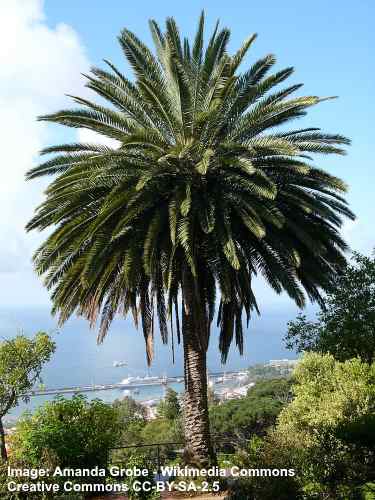
The beautiful Canary Island date palm tree is suitable for the southern parts of Texas
The Canary Island date palm is an easily recognizable evergreen tree in warm Texas landscapes. The elegant palm tree has a distinctive crown consisting of arching feather-like fronds and an erect, rough, upright trunk with a diamond pattern. At its mature height, the Canary Island date palm reaches 40 to 60 ft. (12 – 18 m) tall.
This majestic evergreen palm is heat, cold, drought, and salt-tolerant. The Canary Island date palm thrives in USDA zones 9 to 11 and needs full sun for best results. You can use the subtropical palm as a specimen palm tree, accent plant, or street tree. It can also tolerate freezing conditions as low as 18°F (-8°C).
Texas Palm Tree Identification
The majestic Canary Island date palm is easily recognizable due to its feather-like arching green fronds, thick columnar diamond-patterned trunk, and its showy clusters of reddish-yellow juicy fruits.
Pindo Palm Tree (Butia capitata)
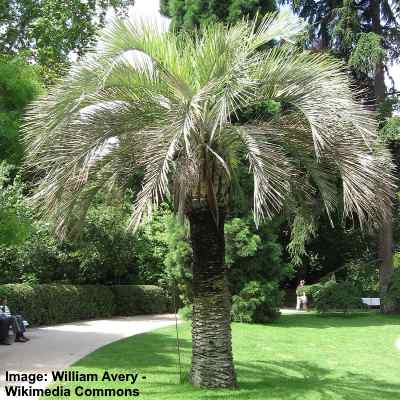
The small decorative pindo palm tree can grace landscapes in South Texas
The pindo palm is a small palm tree recognized by its bluish-green feather-like weeping fronds, stout trunk, and showy clusters of sweet dates. The cold-hardy feather palm has arching petioles growing 3 to 6 ft. (1 – 1.8 m) long. In the summer, clusters of small fragrant flowers bloom, followed by date-like fruits that taste like pineapple.
The slow-growing pindo palm tree (also called jelly palm) thrives in Texan landscapes in zones 9 to 11. Suitable for the upper Gulf coast, you can grow this sun-loving palm as a specimen palm tree or grouped with other palms for a dramatic effect. It matures at 10 to 20 ft. (3 – 6 m) tall and up to 15 ft. (5 m) wide.
Texas Palm Tree Identification
The pindo palm tree is identified by its elegantly arching pinnate fronds, a rugged cylindrical trunk, clusters of drooping white flowers 3 ft. (1 m) long, and showy date clusters.
Needle Palm Tree (Rhapidophyllum hystrix)
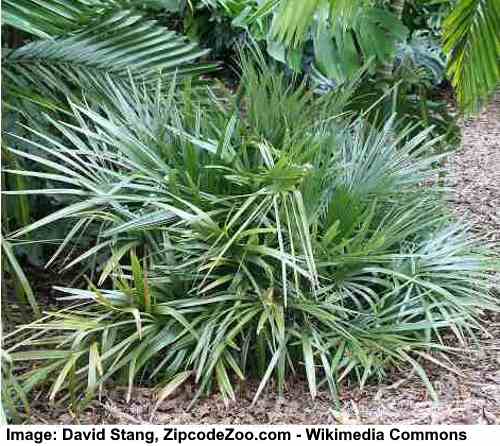
The needle palm tree is very cold hardy and can grow in all parts of Texas
The needle palm is a cold-hardy, shrub-like palm tree that can grow as far north in Texas as Amarillo. Needle palms have large, lustrous green leaves measuring 3 ft. (1 m) in diameter with up to 12 stiff, slender segments creating an open fan shape. The needle palm grows between 3 and 6 ft. (1 – 1.8 m) tall.
The needle palm is one of the cold-hardiest palms for a Texan landscape, thriving in USDA zones 6 through 10. The palm’s dense foliage and low growth make it a versatile landscaping plant from the Panhandle to the Gulf Coast. Additionally, the shrubby palm grows just as well in full sun as in deep shade.
You can use the ornamental palm as evergreen ground cover in a shade garden, foundation planting, border plant, or container plant.
Texas Palm Tree Identification
The identifying features of the needle palm tree are its stiff, jagged fan-shaped leaves, dense evergreen foliage, and suckering habit.
Cabbage Palm Tree (Sabal palmetto)
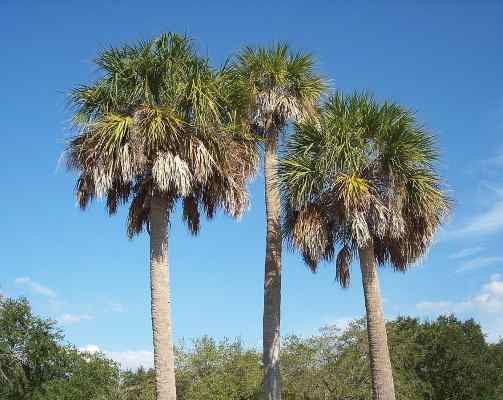
The tall cabbage palm tree is cold hardy and can be grown in South Texas and most parts of central Texas
The elegant cabbage palm is a hardy species of palm tree with a slender gray trunk and crown. This palm grows well in most central and southern Texas areas and the northeast toward Dallas Fort Worth. Its leaves grow up to 6 ft. (1.8 m) long, creating a bushy crown.
The cold hardy cabbage palm tree is suitable for growing in USDA zones 8 through 10. The drought-tolerant palm grows 40 to 50 ft. (12 – 15 m) tall in full sun and moist, well-drained soils. You can grow the palm tree as a specimen palm, in groupings, or coastal regions along the Gulf coast.
Texas Palm Tree Identification
The identifying features of the cabbage palm tree are its large, fan-shaped leaves and smooth gray trunk with petiole residues that create a shaggy appearance near the crown. This palm also features clusters of creamy white fragrant flowers that give way to delicious black fruits.
Mexican Fan Palm Tree (Washingtonia robusta)

The tall and slender Mexican fan palm is a popular tree in Texas gulf coast area
The Mexican fan palm is a spectacular tall palm tree with a single, narrow, smooth trunk growing over 100 ft. (30 m) tall. Its gray trunk has transversal rings and has a characteristic bulge at ground level. The Mexican fan palm’s bushy rounded crown consists of long fan-shaped fronds measuring 5 ft. (1.5 m) long and 4 ft. (1.2 m) wide.
The Mexican fan palm is suitable for planting in coastal areas in USDA zones 9 to 11. As one of the most popular landscaping palms in Texas, these palm trees are common all along the Texas upper gulf coast area. These ornamental exotic palm trees are ideal as tall accent plants in warm, humid regions.
Texas Palm Tree Identification
The identifiable features of the Mexican fan palm are its slender columnar trunk, small crown of fan-shaped leaves, and a distinctive swelling at the base. Another characteristic to help distinguish the palm tree is the way dead leaves lay flat against the trunk.
Queen Palm (Syagrus romanzoffiana)
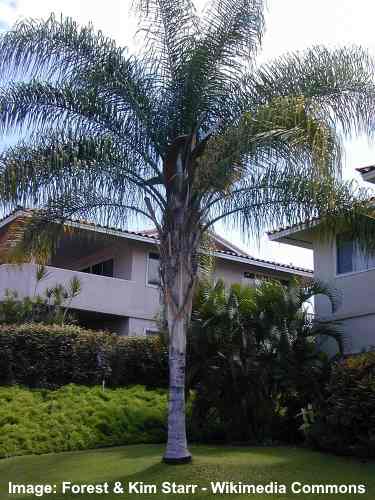
The queen palm is a popular ornamental fast growing tree in south Texas
The queen palm is one of the most popular landscaping palm trees in the warm regions of the Lone Star state. Queen palms in the Texas landscape are identified by their arching feather-like fronds creating an impressive canopy. In addition, the palm’s trunk is smooth and gray with distinctive ringlets around it.
Queen palm is a tall tree growing 50 to 70 ft. (15 – 21 m) tall in USDA zones 9 to 11. In spring and summer, the palm blooms with showy white flower clusters followed by showy, dangling clusters of orange edible fruits. This palm is popular in subtropical, coastal landscapes in consistently moist soils.
It’s important to note that the queen palm is not as cold-hardy as the other Texas palms—it usually suffers damage in temperatures below 25°F (-3°C).
Texas Palm Tree Identification
Identification characteristics of the queen palm are its long, slender, smooth trunk with a relatively small crown of pinnate green leaves. Additionally, the exotic palm tree has irregular bulges on its smooth, gray trunk and dangling clusters of creamy-white flowers.
Related articles:
